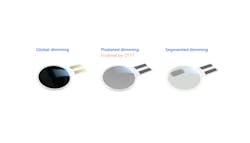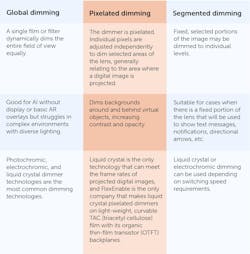Augmented reality and smart glasses need variable dimming for all-day wearability
Augmented reality (AR) glasses and smart glasses have been available for more than a decade, but adoption by the market is moving slowly. Within the past year, smart glasses gained momentum largely driven by the widespread integration of artificial intelligence (AI). The competitive landscape is no longer just about the hardware but is increasingly about the platforms and ecosystems being built by big tech players such as Google, Meta, and Apple, which are forming strategic partnerships to draw more users into their respective platforms.
AI is providing content and new use cases that were sorely missing from the head-wearable AR market. Smart glasses enable seamless all-day access to AI, which can provide guidance throughout the day and promise “superhuman” capabilities.
The rapid adoption of smart glasses is most notable with the launch of Ray-Ban Meta Wayfarer glasses. Reportedly, two million units of the smart glasses were sold during 2024, and sales are projected to grow substantially in 2025—with a target of 10 million units per year by 2026.
Meta’s recent introduction of Meta Ray-Ban Display, AI glasses with a full-color display, fueled excitement for this technology. Meta’s competitors are also developing AI glasses. Apple’s first AI glasses are expected to debut in 2026, while Xiaomi unveiled its first AI glasses during June 2025. Google, which arguably started the latest phase of AR with Google Glass, is back in the game and is partnering with Magic Leap and Samsung on hardware.
Key players are strategically positioning themselves to capture a significant share of the glasses market. In some cases, this involves partnerships with fashion brands like Meta’s successful collaboration with Essilor Luxottica. Similarly, Google is working with Gentle Monster and Warby Parker to develop smart glasses powered by Android XR.
The world of fashion sunglasses and AR glasses are converging, and sunglasses and prescription glasses of the future will likely feature an embedded AR function, much like most new cars today are equipped with a navigation system and smart features.
Changes in ambient light
An augmented image greatly extends the capabilities of smart glasses. Some early instances of AR display use cases include envisioning what a 3D object looks like within a space, driving directions overlaid with the real world, labeling objects or people within a scene, showing how to make a repair by overlaying instructions on the item to be repaired, or being able to see another person’s expressions during a video call.
Some tech leaders believe AR glasses with displays could replace our smartphones one day. But the widespread adoption of AR glasses depends on many technologies coming together into one form factor: They must shrink both in size and price, have good battery life, and feature optics and displays that create true-to-life images. AR glasses must be useful beyond the “wow” factor of a demo room and be real-world usable.
Dimming is a must-have feature
One of the challenges making AR glasses for the user environment is that people move around throughout the day and encounter changes within lighting conditions and real-world backgrounds that interact with augmented images.
Dimming is an important consideration for all-day wearable devices because it dramatically improves the augmented image quality. The intensity of ambient light varies greatly indoors vs. outdoors. Outdoor light can be as bright as 100,000 nits, while indoor environments are typically much dimmer—falling within the 100- to 500-nit range. It’s important to note that waveguides, birdbath optical, and other combiners can’t project black. A dimmer in dark mode provides a black projection screen for images and occludes the real world. This occlusion increases contrast of the image and preserves color, while improving battery life in the process.
Three types of dimming exist: Global, segmented, and pixelated (see Fig. 1 and table). Global dimming adjusts the brightness of the entire lens, which is often automatically based on ambient light or content. Segmented dimming independently controls fixed portions of the lens and can be used to enhance the contrast of specific information like text messages while maintaining visibility of the real world. And pixelated dimming offers the most immersive experience by selectively dimming individual pixels behind an augmented image, which makes virtual objects appear solid against the real-world background (see Fig. 2).
Integrating dimmers into devices
No matter which dimmer technology is used, key parameters such as transmission range, dimmer color, uniformity, reliability, and power usage must be considered to ensure the glasses provide the expected quality of both the projected and real-world image.
Contrast and transmission: When evaluating dimming technologies, transmission is a key parameter to consider because it directly impacts image contrast. By varying the transmission, AR glasses can dynamically adjust the brightness of the real world. For example, a high transmission allows most ambient light to pass through, which makes the real world appear natural. A low transmission dims the real world and allows virtual images to be more visible. In the case of segmented or pixelated dimming, it is possible to allow the transmission of the real world to be high where there is no augmented image shown, and lower where there is an augmented image projected. The augmented image will have improved contrast, while the real world will be occluded behind the augmented image.
FlexEnable is working with several leading original equipment manufacturer (OEM) brands to deliver high-contrast dimming cells that go as dark as 0.03% transmissive (generally for AR devices used in virtual-reality mode at times), and high-transmission dimming cells that can go up to ~80% for all-day wearable devices.
Switching speed: Fast switching speed is desirable for global and segmented dimmers, and essential for immersive systems in which pixelated dimmers need to move at frame rates to dynamically shadow a projected image. Switching speed is at frame rate and, in some cases, can be <0.1 ms.
Color: The color of the dimmer affects how the user perceives the real world. If the dimmer is not color-neutral, the real world has a noticeable tint. At FlexEnable, we typically provide neutral-colored dimmers but can also tint to switch between different colors as desired by industrial design.
Reliability: Many of the technologies used within AR glasses are still new, so OEMs must ensure these components can be consistently manufactured at scale and have a quick ramp to production. We address these concerns by developing dimming technologies that can be manufactured by existing liquid crystal display (LCD) fabs.
All-day wearable full AR glasses
The journey from AI-enabled smart glasses to truly all-day wearable full AR glasses is long, but progress is being made every day. By integrating AI for practical, everyday assistance, current smart glasses are paving the way for full AR glasses that will seamlessly blend the digital and physical worlds.
About the Author
Erin McDowell
Erin McDowell spearheads the AR/VR business development operations for FlexEnable, where she oversees commercial programs with some of the world’s biggest brands in consumer electronics. McDowell holds more than 50 patents in AR/VR optics, as well as an electrical engineering degree from Washington University in St. Louis.


